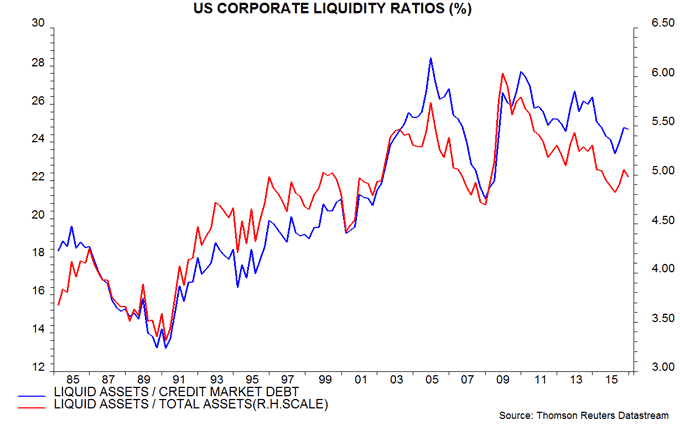Entries from March 19, 2017 - March 25, 2017
US earnings revisions suggesting ISM peak
US narrow money trends may be starting to recover but earlier weakness suggests slower economic growth through late 2017. The latest US earnings revisions data are consistent with an imminent peak in the widely-watched ISM manufacturing new orders index. Chinese earnings revisions, by contrast, have strengthened.
The six-month rate of change of US real (i.e. consumer price-adjusted) narrow money peaked in April 2016 and fell sharply from August, turning slightly negative in February. As previously discussed, momentum changes in real narrow money have consistently led those in GDP in recent years, with the relationship suggesting that two-quarter GDP growth peaked in the fourth quarter of 2016 and will fall through the third quarter of 2017 – first chart.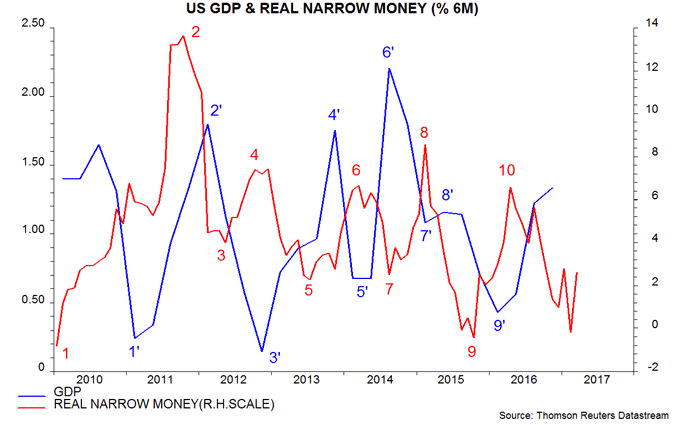
Real narrow money growth, however, may be recovering in March – the last data point in the first chart is a March estimate based on the latest weekly nominal number (for the week to 13 March) and an assumed 0.2% monthly increase in the CPI. The recovery probably partly reflects income tax refunds catching up with the normal schedule after a delay due to legal changes: refunds fell by $25 billion year-on-year in February but the daily average so far in March (i.e. to 22 March) is up by 25% from March 2016, suggesting a full-month gain of $21 billion.
In addition, the Treasury has run down its cash balance to maximise its borrowing headroom ahead of difficult negotiations with Congress over raising the federal debt ceiling. The Treasury’s general account balance at the Fed has fallen from $391 billion in late January to $71 billion in the latest week. Funding the deficit by running down cash boosts bank reserves and money measures, ceteris paribus.
The forecast of softer economic momentum through the third quarter implies that short-term leading indicators such as the ISM manufacturing new orders index should be at or near a peak. Regional Fed manufacturing surveys released so far in March have been super-strong, generating expectations that the next ISM reading will remain buoyant. However, the US earnings revisions ratio (i.e. analyst upgrades minus downgrades as a proportion of the total number of earnings estimates, seasonally adjusted) correlates reasonably well with the ISM (correlation coefficient = 0.72 since 2005) and fell in March – second chart.
The Chinese revisions ratio, by contrast, reached its highest level since 2013, suggesting a strong National Bureau of Statistics (NBS) March manufacturing purchasing managers’ survey – third chart.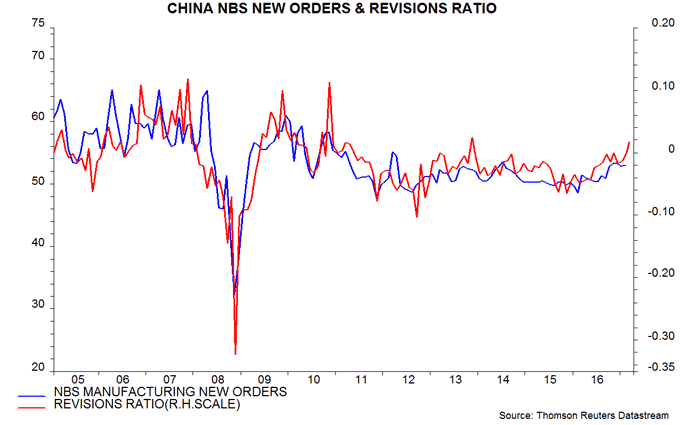
UK inflation rise due to loose money not Brexit
A post in October 2016 forecast that UK CPI inflation would rise above 3% in 2017, exceeding Monetary Policy Committee (MPC) and consensus projections. This was based on “core” inflation moving up to about 2.5% by late 2017 and higher sterling commodity prices lifting the headline / core gap to over 1 percentage point*. February numbers released yesterday are consistent with this forecast: core inflation rose to 1.9%, the highest since 2012, and the headline / core gap to 0.4 – see first chart.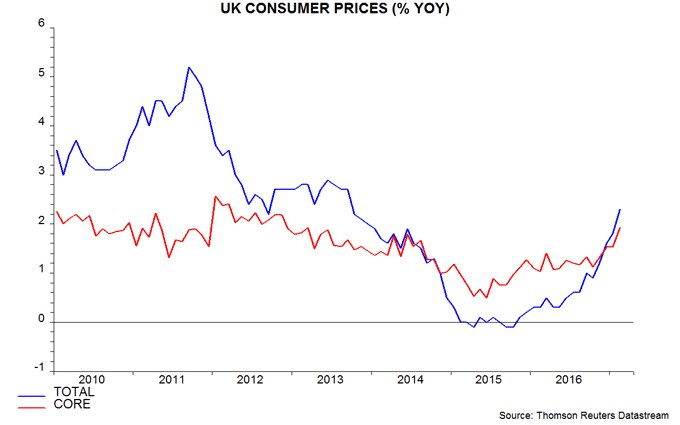
The MPC argues that the inflation rise is a temporary consequence of sterling weakness caused by the Brexit vote. A “monetarist” view, by contrast, is that inflation is climbing in lagged response to a significant pick-up in monetary growth between 2011 and 2016. Annual broad money expansion, as measured by non-financial M4, rose from below 2% in 2011 to nearly 7% late last year – second chart. A post in May 2016 showed that similar upswings in monetary growth historically were followed by a sustained rise in core inflation. The post suggested that core inflation would be on an upward trend from late 2016.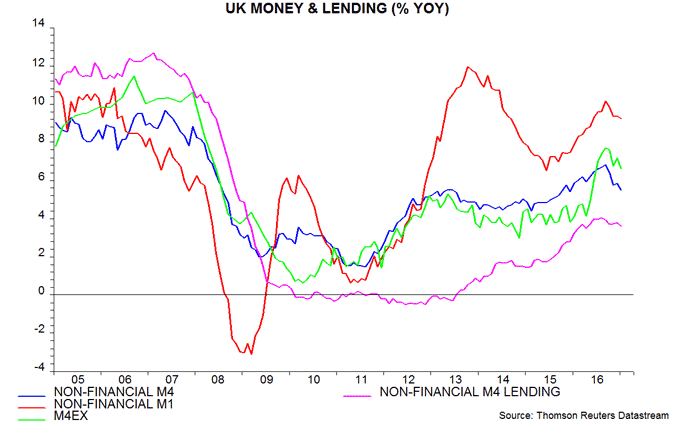
The weaker exchange rate, on this view, is part of the “transmission mechanism” from faster money growth to higher inflation, rather than being a primary driver. It is plausible that sterling would be significantly higher if the Brexit referendum had resulted in a “remain” vote. In that case, however, the economy would probably be much stronger – a post in December 2016 suggested that GDP would have grown at an annualised rate of about 3.5% during the second half of 2016 rather than the currently-estimated 2.6%. Greater upward pressure on domestic costs and margins, therefore, would have counterbalanced a smaller import price boost. (The annual rate of change of the GDP deflator, a measure of domestically-generated inflation, rose to 2.8% in the fourth quarter of 2016, an eight-year high.)
The monetarist view implies that the inflation rise will be a level shift rather than a temporary “blip”. Annual non-financial M4 growth has retreated from a peak of 6.8% in September 2016 to 5.5% in January but remains elevated by the standards of recent years. The analysis in the May 2016 post found a two- to three-year average lead from money growth to core inflation, suggesting that upward pressure on the latter will persist through late 2018, at least.
Current broad money growth, admittedly, remains modest relative to the 1980s, 1990s and 2000s – non-financial M4 rose by 9.0% per annum (pa) on average over the 30 years to end-2009. The velocity of circulation of non-financial M4, however, fell by an average of 2.9% pa over this period**. Negative real deposit interest rates have reduced the demand for broad money, resulting in velocity stabilising since 2009. Sustained money growth at its current 5.5% pace, therefore, would suggest a similar rate of expansion of nominal GDP. With potential economic growth generally estimated to be 1.5-2.0% pa currently, such a rate of increase would be incompatible with the 2% inflation target***.
The monetarist view implies that the MPC should have raised interest rates last year as money growth was rising strongly, rather than easing policy in a panic reaction to the Brexit vote. The Committee may choose to reverse the August cut over coming months as inflation exceeds its forecast but is likely to continue to claim falsely that the pick-up is a temporary and unavoidable consequence of Brexit and does not require a fundamental policy rethink. A reasonable assessment is that the MPC has, in effect, shifted from inflation- to unemployment-targeting: the latest Inflation Report, after all, projects that the jobless rate will remain stable at close to its current level through 2020 even as inflation heads for a sustained overshoot.
*”Core” = CPI excluding energy, food, alcohol, tobacco and education adjusted for VAT changes.
**Velocity definition incorporates six-quarter lag on money stock.
***2017 potential growth estimates: OBR 1.9%, IMF 1.8%, EU Commission 1.6%, OECD 1.5%.
US corporate finances unpromising for business spending
US corporate profits weakened in the fourth quarter of 2016, casting doubt on expectations that business spending will drive a pick-up in economic growth.
Fourth-quarter financial accounts released by the Federal Reserve on 9 March contain the first official estimate of corporate profits calculated on a national accounts basis. Both headline profits and an “economic” measure that adjusts for stock appreciation and over- / under-depreciation fell between the third and fourth quarters. Economic profits were 11% below a peak reached in the fourth quarter of 2014 – see first chart.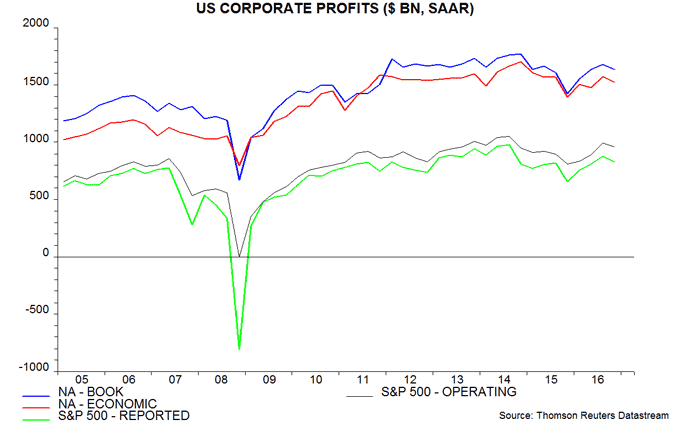
These numbers may be revised in the “final” GDP report for the fourth quarter to be released on 30 March. As the chart shows, however, the quarterly decline in the national accounts profits measures tallies with S&P data on the aggregate reported and operating earnings of S&P 500 companies.
Bullish commentary may have been influenced by a sharp rise in year-on-year S&P 500 reported earnings per share (EPS) growth – from 9% in the third quarter to 29% in the fourth, according to S&P – but this is entirely explained by a favourable base effect due to EPS falling by 19% between the third and fourth quarters of 2015.
The profits measures in the first chart tend to lead the consensus 12-month forward S&P 500 EPS estimate. The fourth-quarter profits fall suggests downside risk to the current consensus estimate – second chart.
The Fed’s financial accounts show that the “financing gap” of non-financial corporations – the difference between their capital spending and retained earnings – rose to 0.4% of GDP in the fourth quarter, close to its long-term average (i.e. over 1985-2015) of 0.6%. This measure, however, understates the growth of leverage in recent years because it excludes borrowing to finance share buy-backs and cash takeovers. A broader corporate deficit measure adding in net equity purchases reached 3.8% of GDP in the second quarter of 2016 – significantly above a long-term average of 2.1%. It fell back, however, in the fourth quarter as net equity buying slowed sharply – third chart.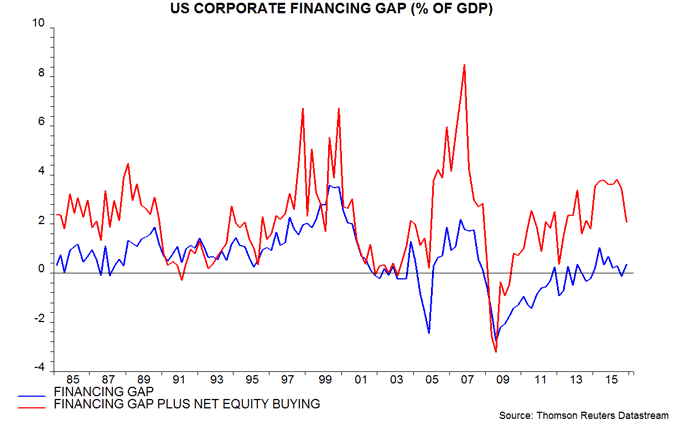
The financing gap measures have been inversely correlated with the future rate of change of business investment historically. The recent elevated level of the broader measure suggests that investment will grow moderately at best over coming quarters – fourth chart
The broader measure also correlates, with a typical lag of six quarters, with the yield spread between low-rated corporate bonds and Treasuries. This relationship suggests that the current spread is significantly below “fair value” – fifth chart.
One favourable balance sheet development recently has been solid growth of broad money holdings – non-financial corporate M3 rose by 6.6% in the year to end-2016. Liquid assets, nevertheless, have fallen since 2009-10 relative to credit market debt and the overall balance sheet – sixth chart.